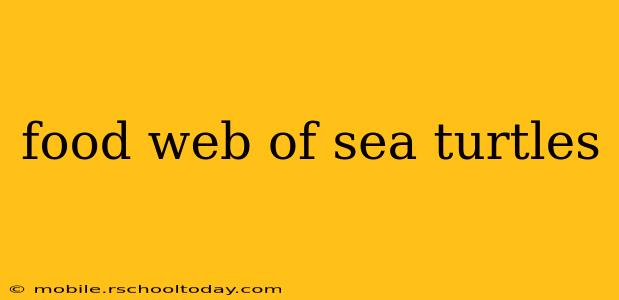Sea turtles, ancient mariners of the ocean, occupy a fascinating niche within complex marine ecosystems. Understanding their role requires delving into the intricate web of interactions they have with other organisms. This detailed exploration will unravel the multifaceted food web of sea turtles, examining their position as both predator and prey, and highlighting the crucial role they play in maintaining ocean biodiversity.
Sea Turtles: Predators and Prey in the Marine Food Web
Sea turtles are primarily herbivores or omnivores, depending on the species. Their diet significantly impacts the marine food web.
What Sea Turtles Eat: A Species-Specific Overview
-
Herbivorous Species (e.g., Green Sea Turtles): These turtles primarily feed on seagrasses and algae, acting as key grazers in seagrass meadows and coral reefs. Their grazing habits directly influence the structure and health of these vital habitats. They control the growth of seagrasses, preventing overgrowth and maintaining biodiversity.
-
Omnivorous Species (e.g., Loggerhead Sea Turtles): These turtles exhibit a more varied diet, incorporating invertebrates like jellyfish, crabs, and shrimp, along with algae and seagrasses. Their predation on invertebrates helps regulate populations and maintain a balanced ecosystem.
-
Carnivorous Species (e.g., Leatherback Sea Turtles): Unlike other species, leatherbacks primarily consume jellyfish, making them apex predators in their specific niche. Their consumption of jellyfish helps control jellyfish blooms, which can have devastating effects on other marine life.
Sea Turtles as Prey: The Dangers Lurking Beneath the Waves
Despite their size and strength, sea turtles are not immune to predation. Various creatures pose significant threats throughout their life cycle:
-
Eggs and Hatchlings: Numerous predators target sea turtle nests and hatchlings on beaches, including foxes, dogs, birds, and crabs. The journey from nest to ocean is perilous, with high mortality rates.
-
Juveniles and Adults: Larger predators like sharks, orcas, and crocodiles can prey on juvenile and adult sea turtles. Fishing gear also presents a substantial threat, often resulting in accidental drowning or injury.
The Ripple Effect: Sea Turtles' Influence on Marine Ecosystems
Sea turtles' impact on the marine food web extends far beyond their diet and predation. Their role as keystone species is undeniable:
-
Seagrass Meadow Maintenance: Green sea turtles’ grazing helps maintain the health and biodiversity of seagrass meadows, crucial habitats for countless marine organisms.
-
Nutrient Cycling: Their feeding and waste contribute to nutrient cycling within the ecosystem, supporting the growth of other plants and animals.
-
Coral Reef Health: Some sea turtle species help maintain coral reef health through grazing on algae, preventing algal overgrowth that can smother corals.
-
Population Control: Their predation on jellyfish and other invertebrates helps regulate populations, preventing imbalances that could disrupt the ecosystem.
Conservation Implications: Protecting the Sea Turtle Food Web
The health and stability of sea turtle populations are intrinsically linked to the overall health of marine ecosystems. Threats like habitat destruction, pollution, climate change, and fisheries bycatch significantly impact sea turtle populations and their intricate role in the food web. Conservation efforts focusing on protecting nesting sites, reducing bycatch, and mitigating climate change are vital to preserving these ancient mariners and the delicate balance they maintain within the ocean’s food web.
Conclusion: A Complex Interplay of Life
The food web of sea turtles is a complex and dynamic system with far-reaching consequences. Understanding these intricate interactions is crucial for effective conservation and the preservation of marine biodiversity. By appreciating the role of sea turtles as both predators and prey, we can better protect these magnificent creatures and the oceans they call home.
